Part 2: 다중 호스트 비디오 통화 (데스크톱 PC) – 비디오 SDK 비교
이 블로그는 Zoom과 아고라를 다양한 실시간 비디오 시나리오에서 비교하는 시리즈의 일부입니다. Agora의 상세한 테스트는 1:1 PC 통화 시나리오에서 SDK의 성능 우위를 입증했습니다. 모든 테스트 시나리오의 요약은 이 블로그를 확인하세요: Agora vs. Zoom: 비디오 SDK의 종합 비교
Zoom이 의뢰한 벤치마크 테스트를 계속 분석해 나가면서, 실시간 비디오를 앱에 추가하는 것이 참여도를 높이고 비즈니스 기회를 확대한다는 점을 기억하는 것이 중요합니다. 그러나 모든 SDK가 동일하게 만들어진 것은 아닙니다.
비디오 SDK를 선택할 때 전체적인 그림을 보고 큰 그림을 보는 것이 중요하며, 이것이 바로 우리가 Zoom의 결과를 더 자세히 살펴보고 고객이 실시간 참여(RTE) 솔루션을 평가할 때 고려해야 할 요소를 확장하기로 결정한 이유입니다.
이 블로그에서는 8, 16, 32명의 참가자가 참여하는 PC 기반 다중 호스트 비디오 통화 시 다양한 실제 네트워크 환경에서 두 비디오 SDK가 어떻게 비교되는지 살펴봅니다.
각 테스트 사례의 상세한 결과를 확인하려면 다음 블로그를 참고하세요:
테스트 구성 및 시나리오
아고라의 경우, 우리 Native SDK 버전 4.1.0을 사용하여 테스트했으며, Zoom의 경우 최근 Zoom 애플리케이션 버전 5.12.3을 사용하여 테스트했습니다. 이는 Zoom의 최선의 실천 방법이 비교를 위해 적절히 구현되었는지 확인하기 위함입니다.
모든 결과는 수신 테스트 PC에서 관찰 및 측정되었습니다.
TLWR (Too Long, Won’t Read)를 위한 요약:
결과 요약:
- 정상 네트워크 조건 하에서 Agora와 Zoom 모두 원활한 영상 및 음성 품질을 보여주었으며, 통화 시(8, 16, 32) 평균 수신 프레임 속도는 27~28 프레임 초당(FPS) 사이였습니다.
- 상향 링크 패킷 손실 25% 조건에서 Agora는 통화 시(8, 16, 32) 수신 프레임 속도에서 Zoom 대비 2~3 FPS의 약간의 우위를 보였습니다.
- 다운링크 패킷 손실 25% 조건에서 아고라는 줌보다 우수한 성능을 보여주며, 통화 시 수신 프레임 속도(8, 16, 32)에서 4~6 FPS의 우위를 차지했습니다.
- 1Mbps 제한이 적용되었을 때, 수신 테스트 PC는 Zoom과 Agora 모두에서 프레임 속도 저하를 측정했습니다. Zoom은 몇 초 동안 0 FPS로 떨어졌으며, 그 기간 동안 동결된 영상이 발생했습니다. Agora에서는 수신 테스트 PC에서 끊김이나 동결된 영상이 관찰되지 않았습니다. 1Mbps 제한이 제거된 후, Agora는 평균 프레임 속도가 25 FPS에 가까운 수준으로 일관되게 회복되었으며, Zoom은 FPS의 큰 변동과 함께 회복에 어려움을 겪었습니다.
- 장애 조건(1 Mbps 제한 및 25% 패킷 손실)이 적용되었을 때, 수신 테스트 PC는 Zoom과 Agora 모두에서 프레임 속도 저하를 측정했습니다. Zoom은 총 15초 이상 0 FPS로 떨어졌으며, 그 기간 동안 동결된 영상이 발생했습니다. 장애 조건이 제거된 후, Agora는 Zoom보다 높은 평균 수신 프레임 속도(FPS)를 달성하며 복구되었습니다.
- 비트레이트는 비디오 통화를 통해 다른 사람과 소통할 때 매우 중요합니다. 사용자에게 최상의 경험과 품질을 제공하기 위해 주어진 네트워크 조건에서 가능한 한 높은 비디오 전송 속도를 유지하는 것이 필수적입니다. Agora는 Zoom과 비교해 유사하거나 더 높은 전송 및 수신 비트레이트를 달성했습니다.
프레임 속도 테스트
이 테스트에서는 패킷 손실 및 네트워크 조건 제한이 수신 프레임 속도에 미치는 영향을 주로 분석했습니다.
Agora는 SD-RTN™ 네트워크를 공용 인터넷 위에 오버레이로 적용하고, 마지막 마일 연결에서 성능을 최적화하는 기술 및 장치 최적화를 통해 패킷 손실과 기타 네트워크 문제를 최소화합니다. SD-RTN™은 AI 알고리즘을 사용하여 인터넷상의 장애물을 우회해 트래픽을 라우팅하고, 실시간 트래픽을 최적화하여 최고의 성능을 제공합니다. Agora는 또한 패킷 손실의 영향을 완화하여 최종 사용자 경험을 최적화하는 기술을 구현했습니다.
정상 네트워크
정상 네트워크 조건에서 8, 16, 32명의 참가자가 참여한 통화에서 Zoom과 Agora 모두 평균 수신 프레임 속도가 초당 27~28 프레임(FPS) 사이였습니다.
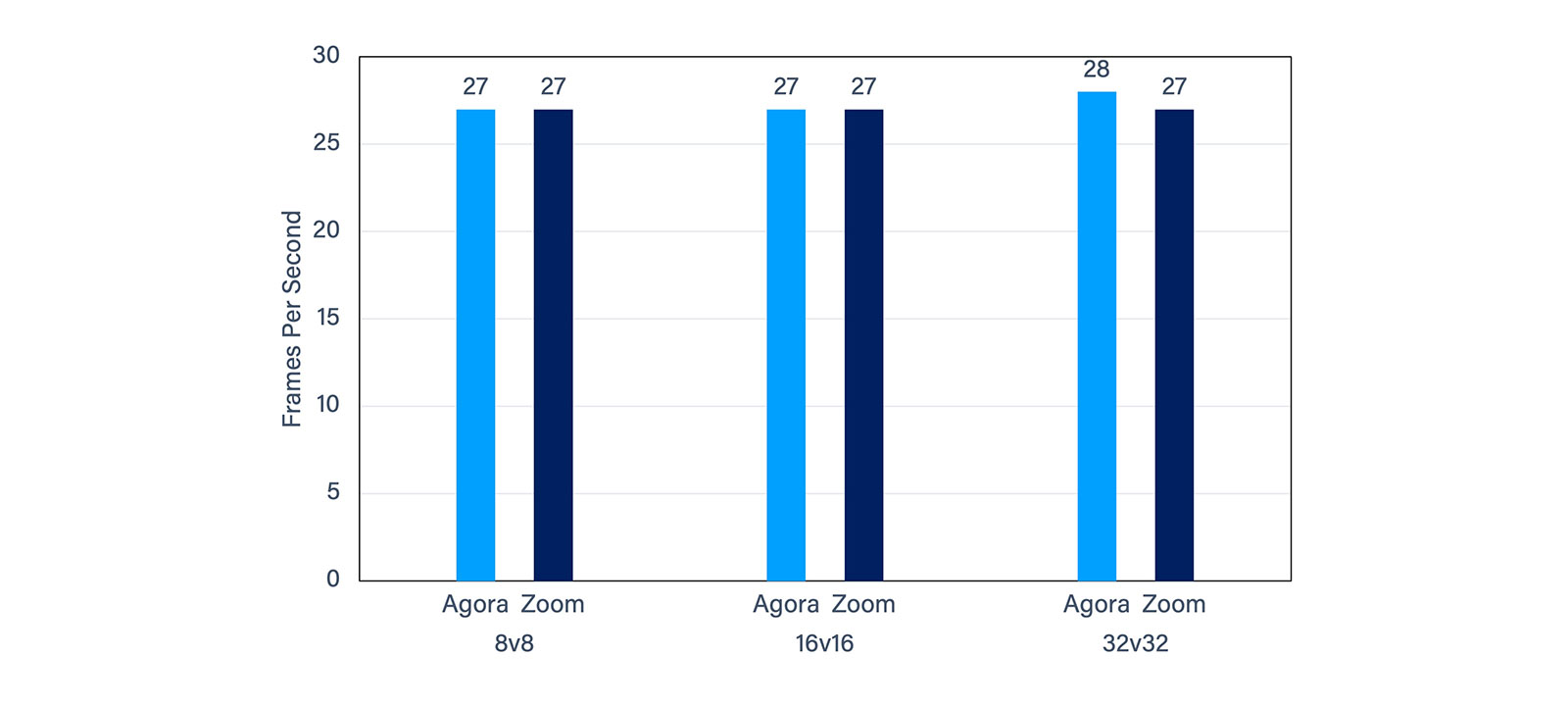
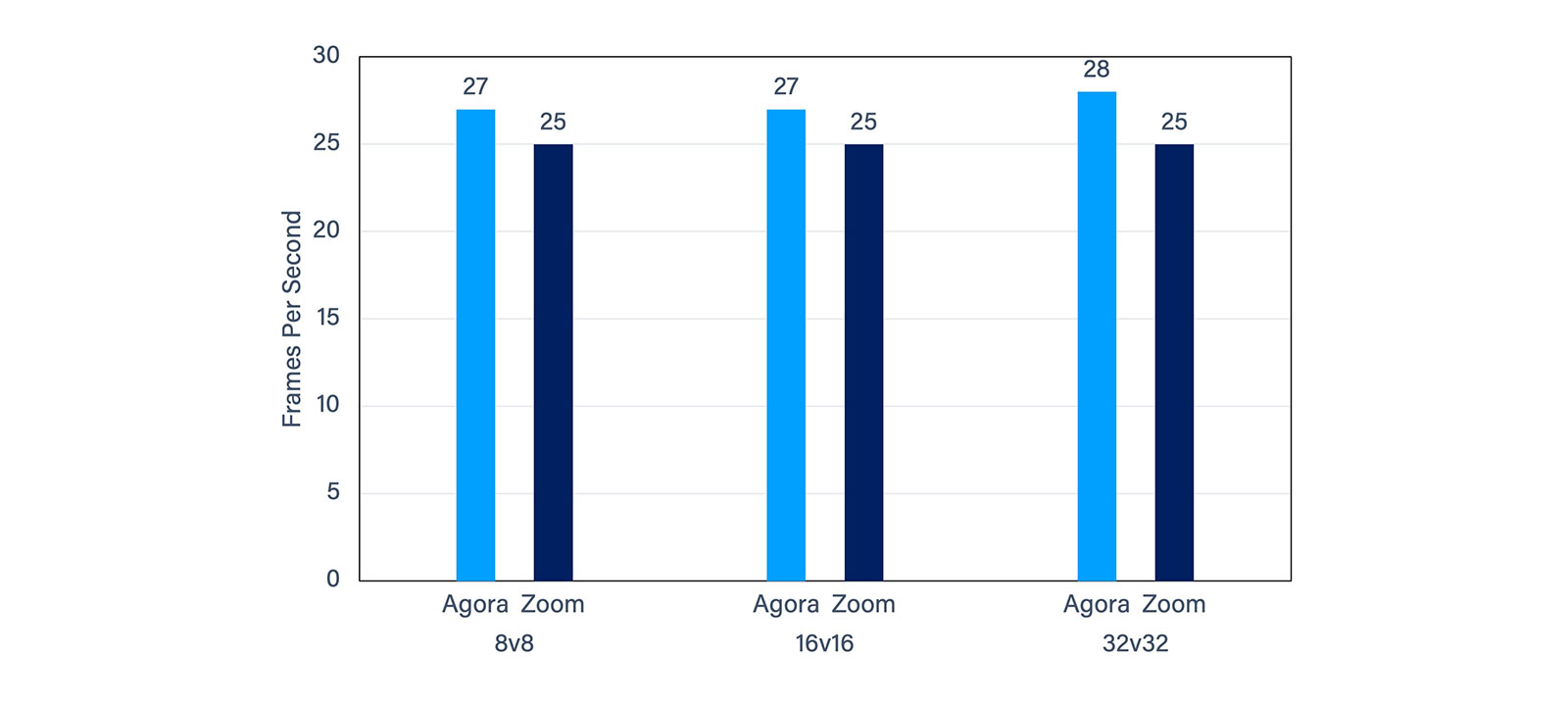
25% Downlink Packet Loss
With 25% downlink packet loss Agora performed better than Zoom with a 6 to 7 FPS advantage against Zoom on the received frame rate in calls with 8, 16 and 32 participants
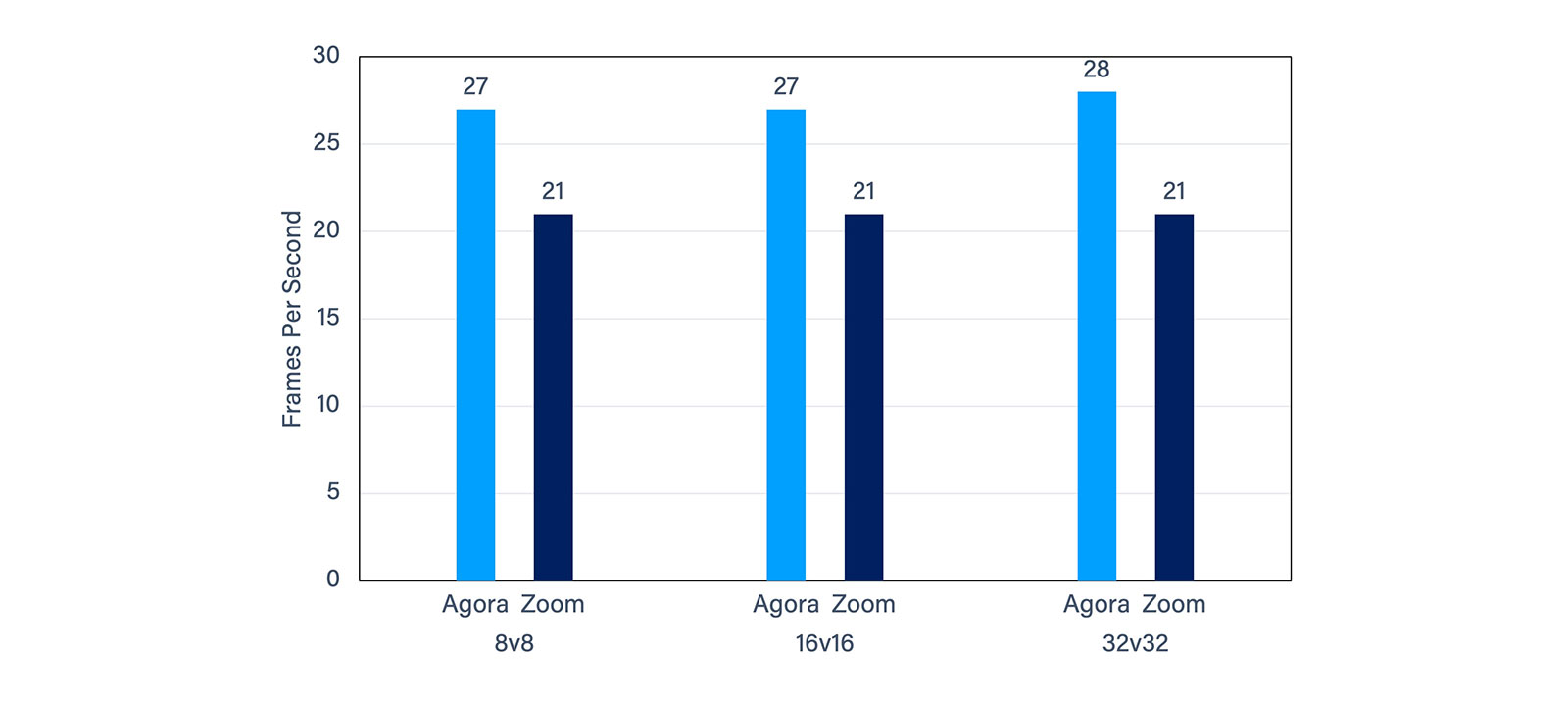
Frame Rate Recovery with 1Mbps Limit
The test started with no bandwidth limitation, then the network was throttled to 1Mbps in the upstream direction and then in the downstream direction for a total of 30 seconds. This simulated a real-world scenario commonly seen on wireless networks.
8 Video Participants
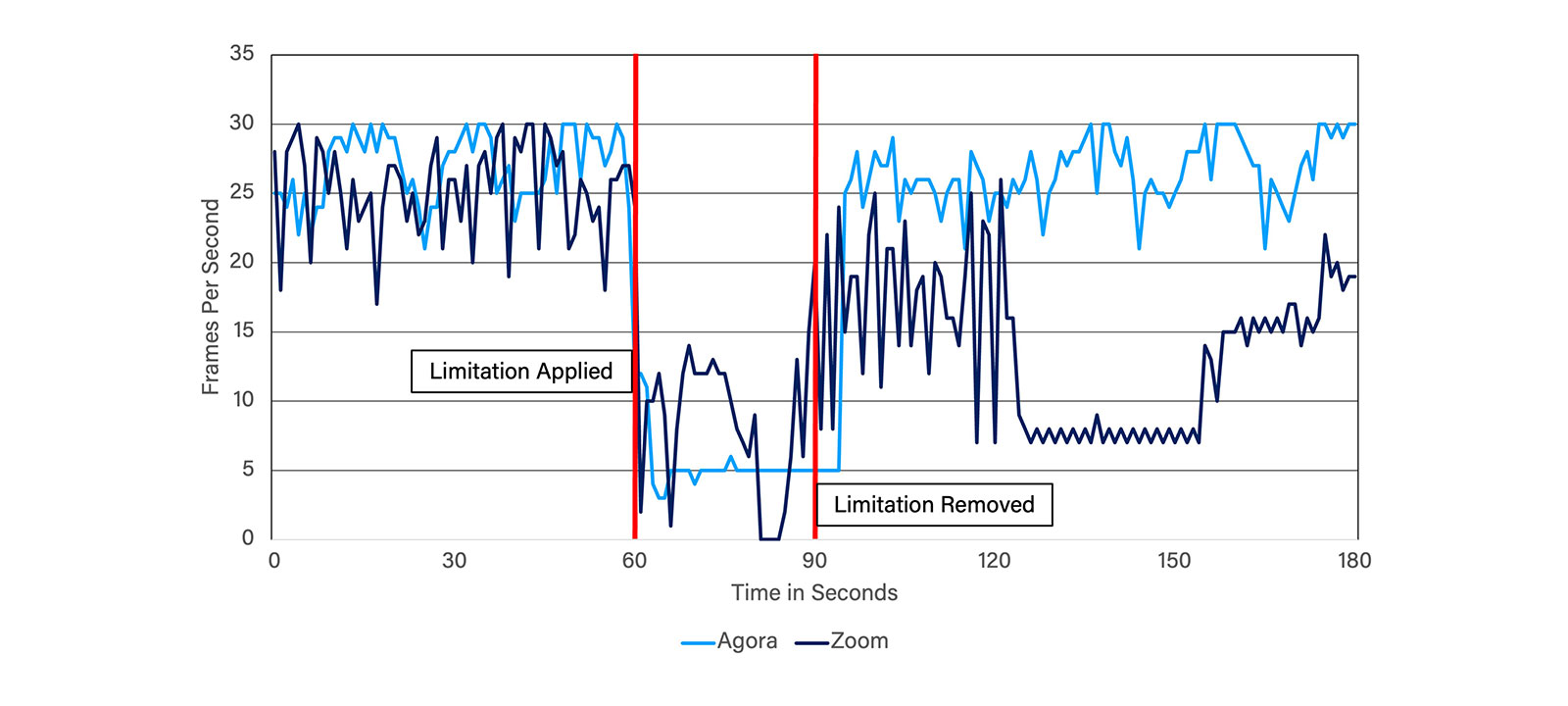
When the 1Mbps limit was applied, the Receive Test PC measured a frame rate drop both for Zoom and Agora. Zoom dropped to 0 FPS for a few seconds and frozen video was experienced during that time. After the 1Mbps limit was removed, Agora rapidly recovered to achieve an average frame rate close to 25 FPS, while Zoom struggled to recover with significant fluctuations in FPS.
16 Video Participants
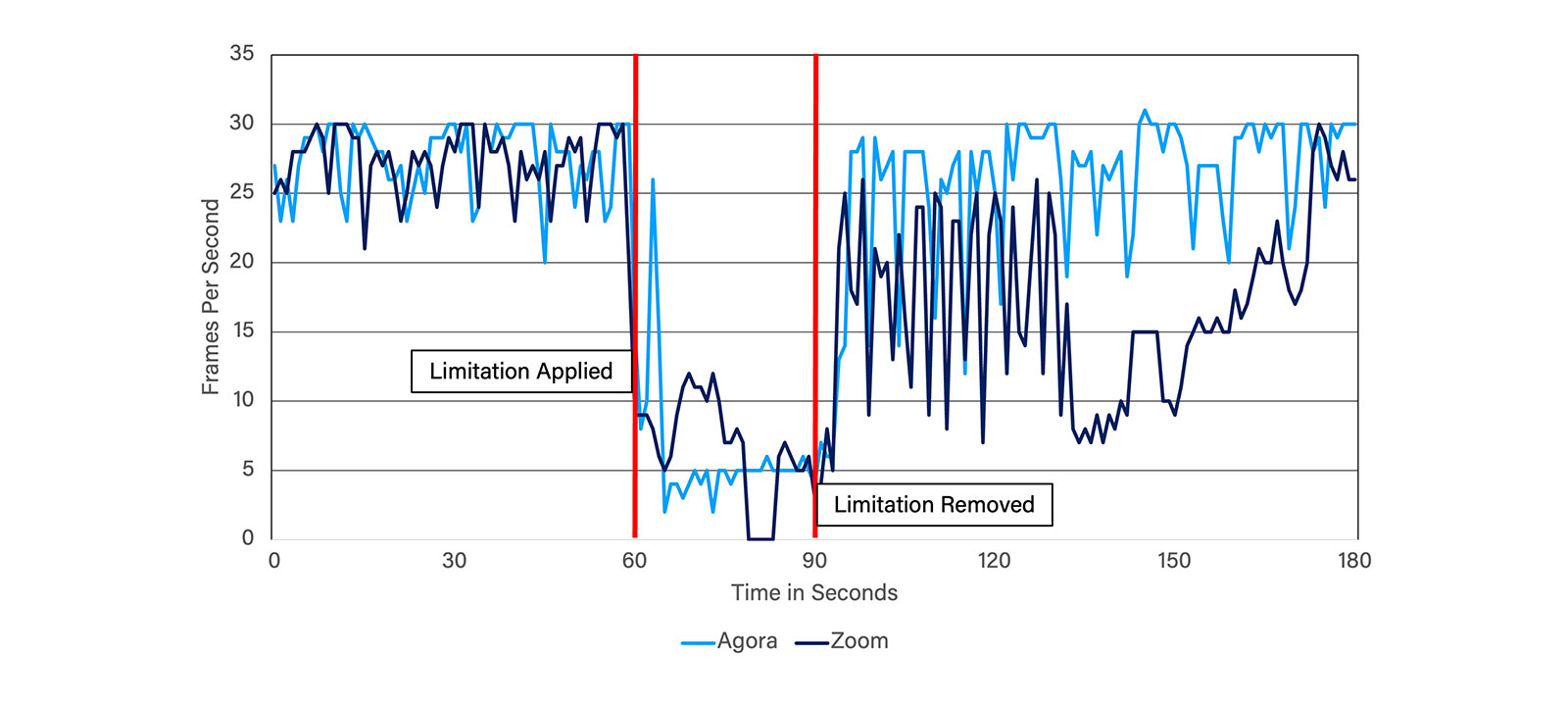
With 16 video participants, the results were very similar to what was observed in the case with 8 video participants above.
32 Video Participants
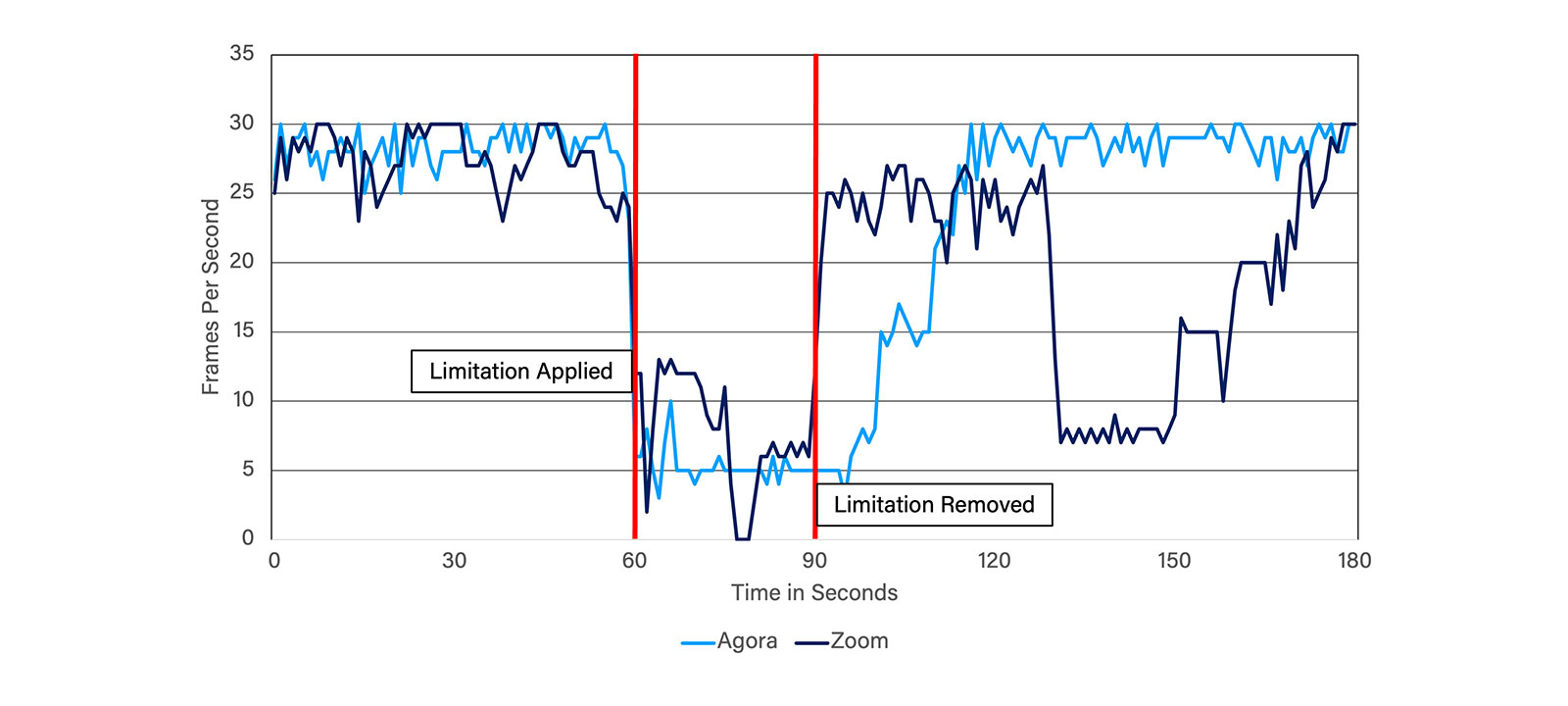
With 32 video participants, the results were very similar to what was observed in the cases with 8 and 16 video participants above. In this case, Agora took about 20 seconds to fully recover, but did so in a smooth and linear fashion. Again, Zoom struggled to recover with significant fluctuations in FPS.
Frame Rate Recovery, 1Mbps Limit and 25% Packet Loss
The test started with no bandwidth limitation, then the network was throttled to 1Mbps in the upstream direction with 25% packet loss applied. Next the network was throttled to 1Mbps in the downstream direction with 25% packet loss applied. The total duration of these impairments was 30 seconds. This simulated a more challenging real-world scenario commonly seen on wireless networks.
8 Video Participants
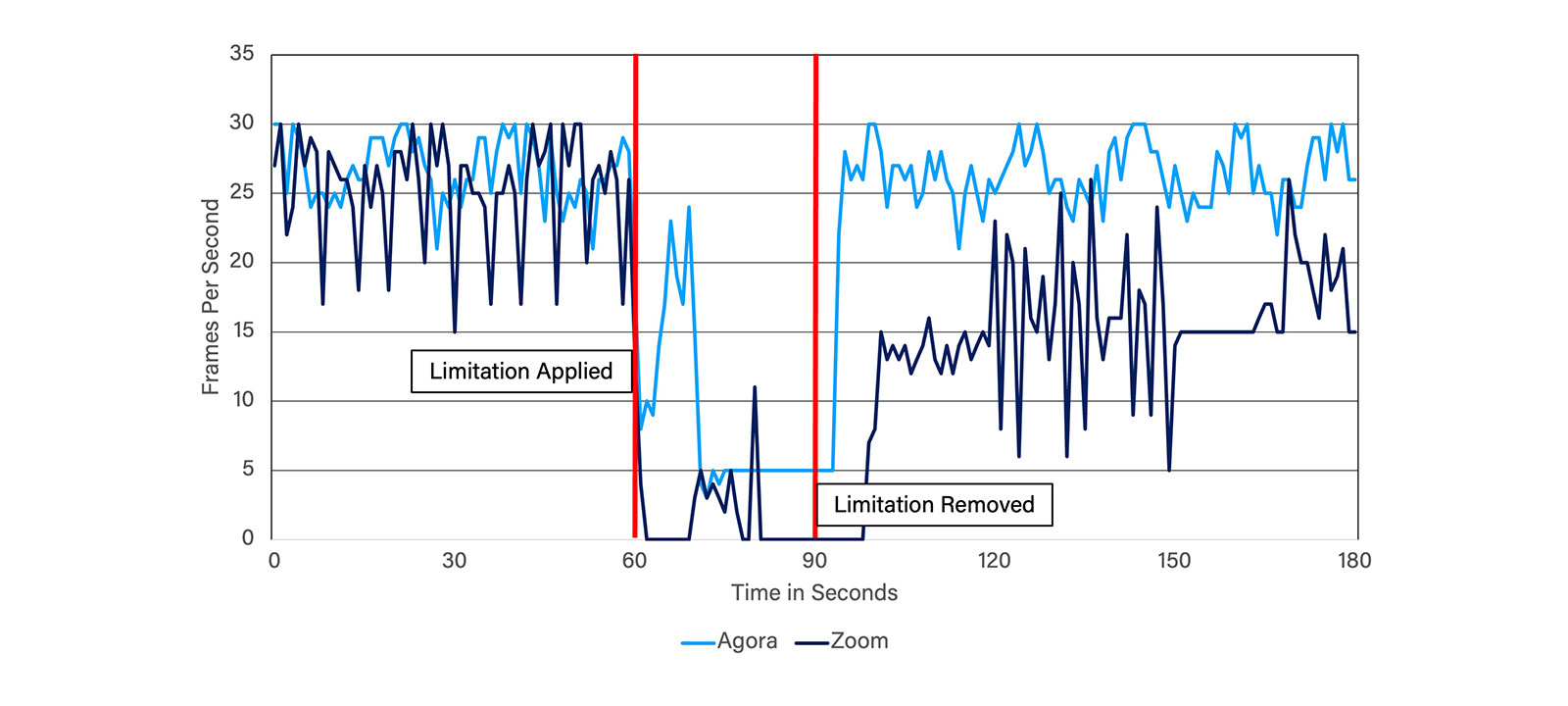
장애 요소가 적용되자, Receive Test PC는 Zoom과 Agora 모두에서 프레임 속도 저하를 측정했습니다. Zoom은 총 15초 이상 0 FPS로 떨어졌으며, 그 기간 동안 동영상이 멈추는 현상이 발생했습니다. 장애 요소가 제거된 후, Agora는 빠르게 회복되어 평균 프레임 속도가 25 FPS에 가까운 수준으로 회복되었지만, Zoom은 동영상이 5초 이상 멈추는 현상을 겪으며 회복에 어려움을 겪었고, 이후 FPS에 큰 변동이 발생했습니다.
16명의 비디오 참가자
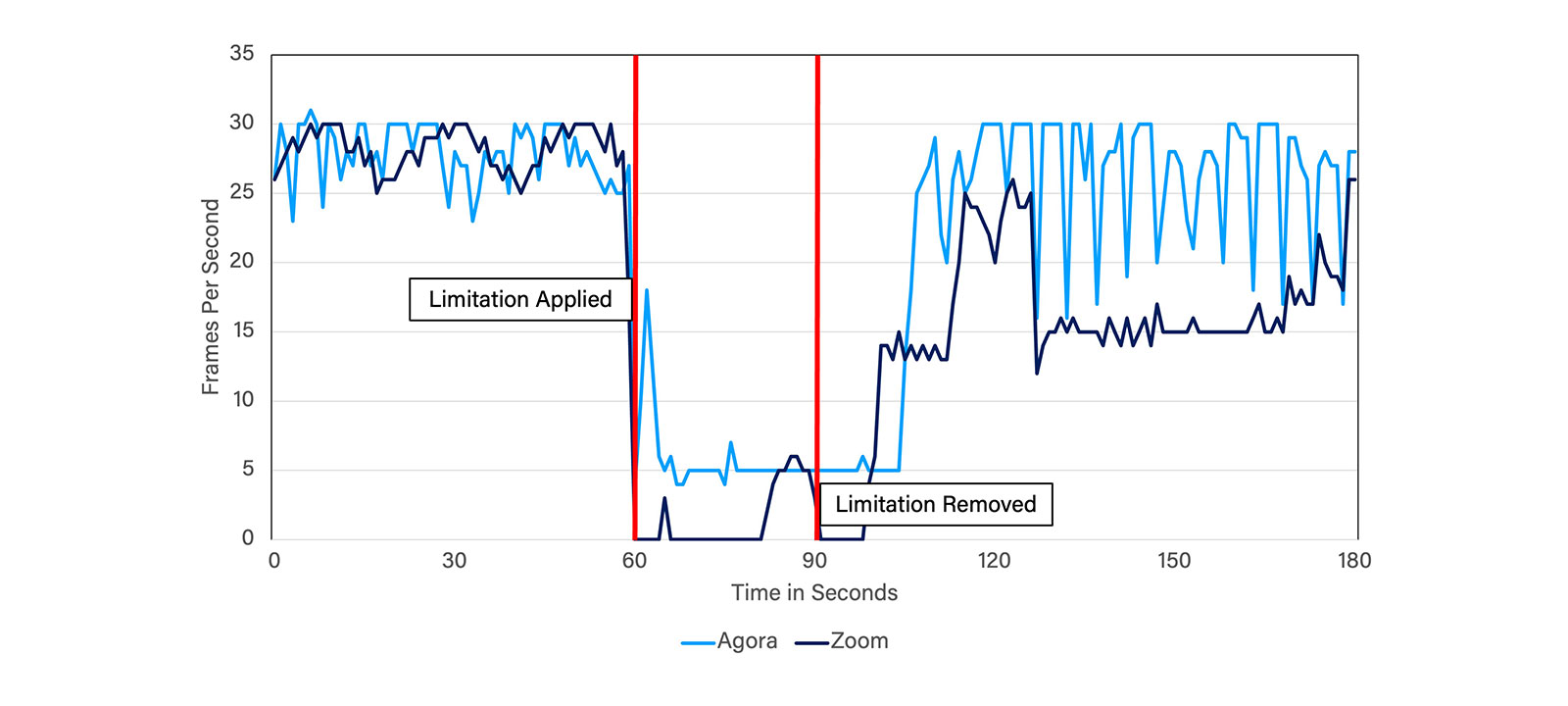
With 16 video participants, the results were very similar to what was observed in the case with 8 video participants above. In this case, after the impairments were removed, the received frame rate on Agora fluctuated more than in the 8-video participant case, however the average FPS remained higher than Zoom.
32 Video Participants
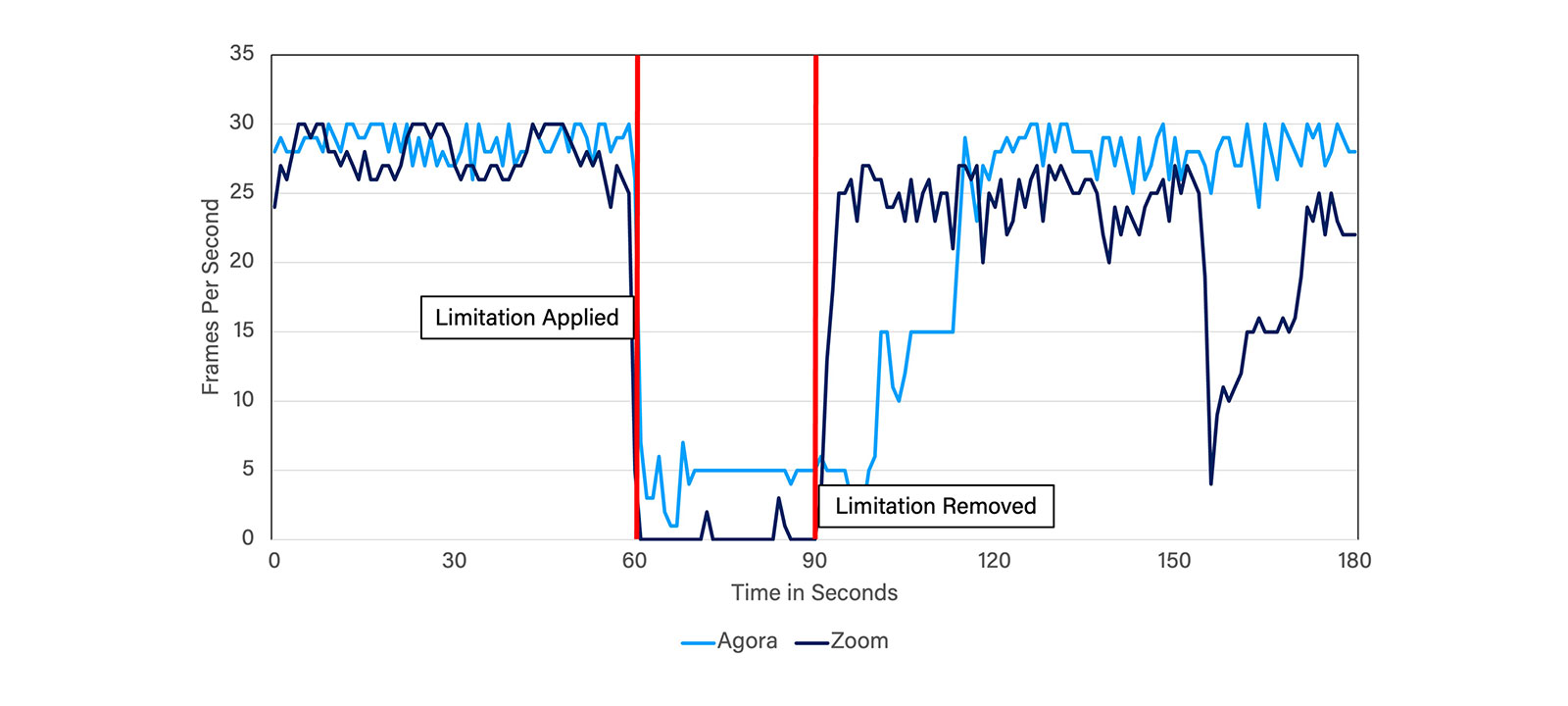
With 32 video participants, the results were similar to what was observed in the cases with 8 and 16 video participants above. In this case, Agora took about 20 seconds to fully recover, but then maintained a stable average FPS of around 27. Zoom initially recovered more quickly, however, a significant fluctuation in FPS was observed from 150-180 seconds.
Bitrate Test
Bitrate is also vital when communicating with others via a video call. To deliver the best possible experience and quality for end users, maintaining the highest possible video throughput for the given network conditions is essential.
The data below focused on the case with 32 video participants for simplicity. The observations for the 8 and 16 video participant cases were similar.
Normal Network
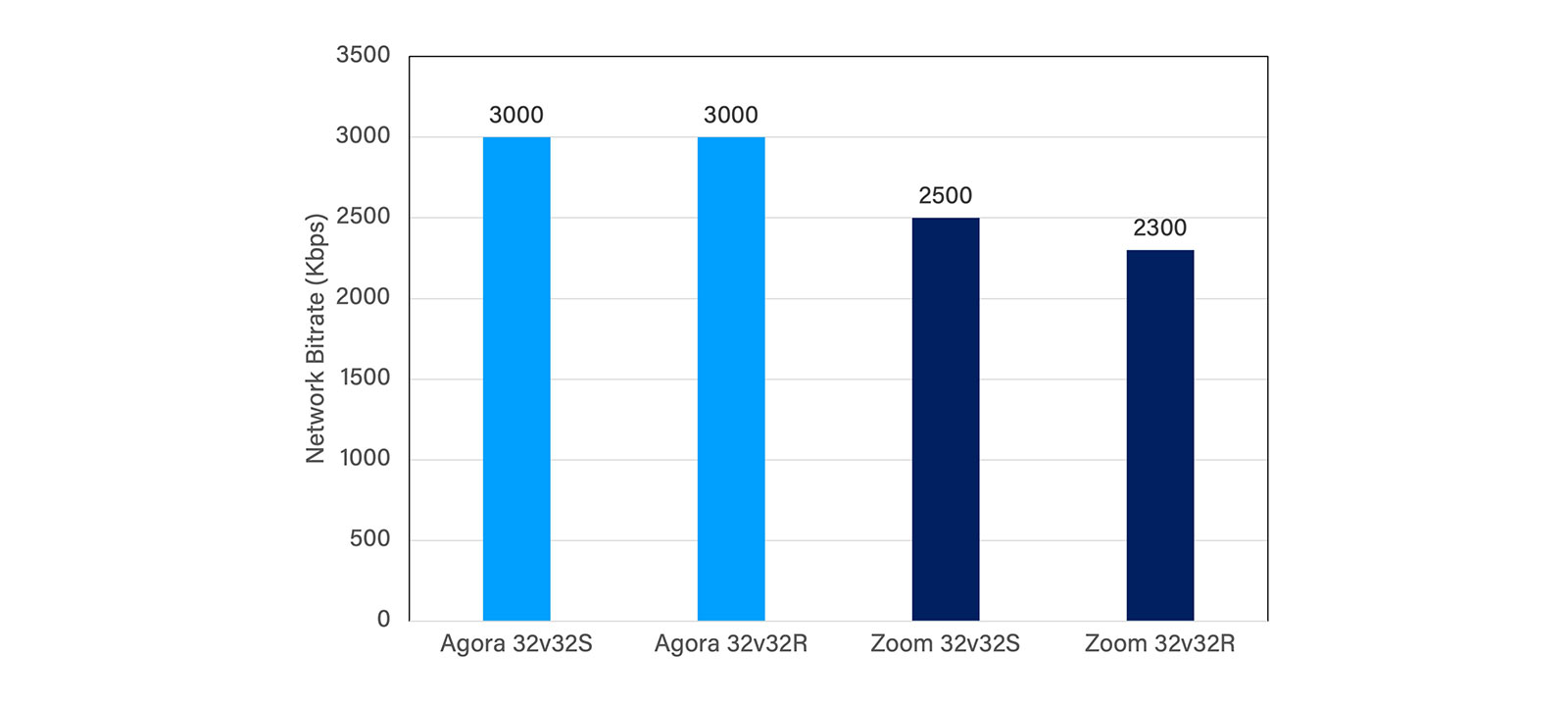
Under normal network conditions, Agora sent and received an average of 3000 Kbps vs. Zoom which sent at 2500 Kbps and received at 2300 Kbps.
25% Uplink Packet Loss
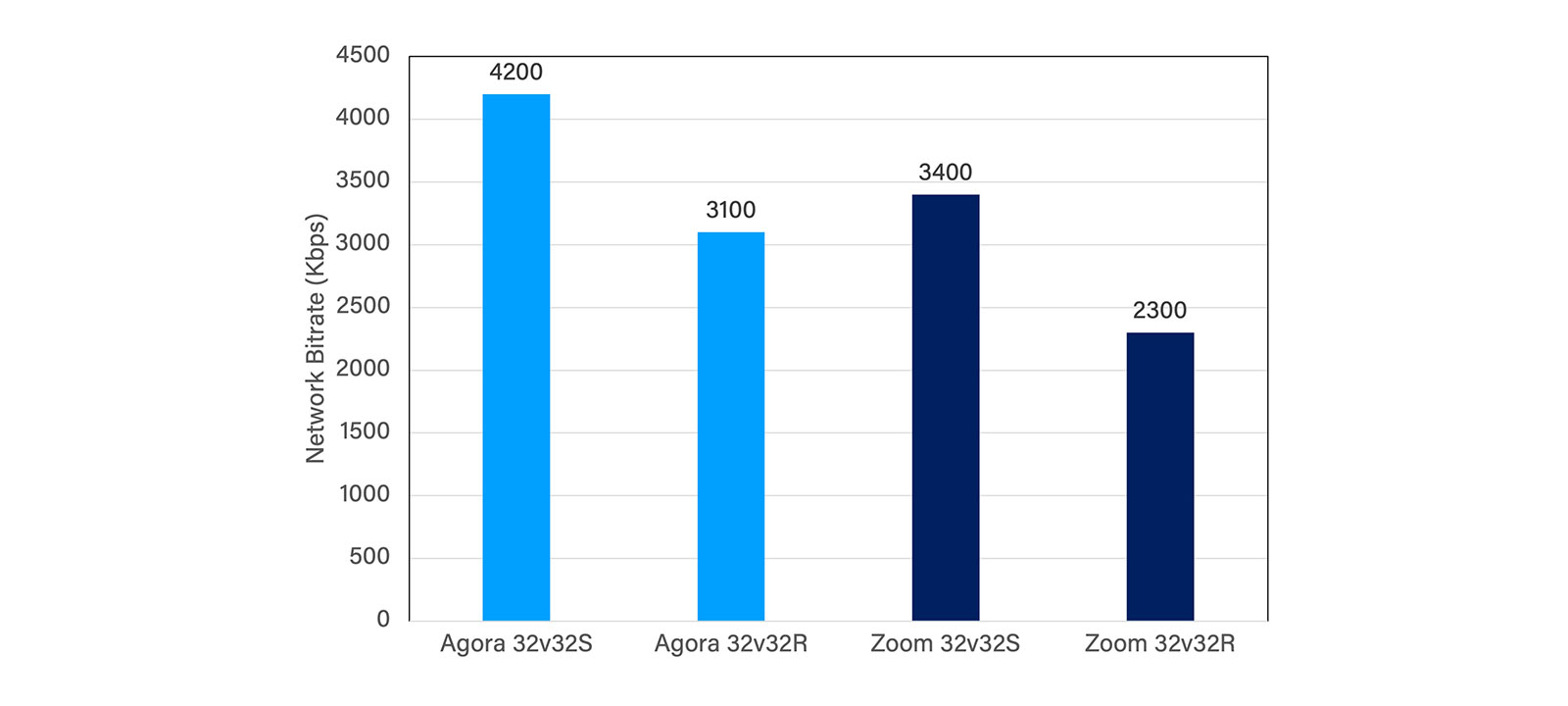
With an uplink packet loss of 25%, Agora’s sent and received bitrate remained higher than Zoom.
25% Downlink Packet Loss
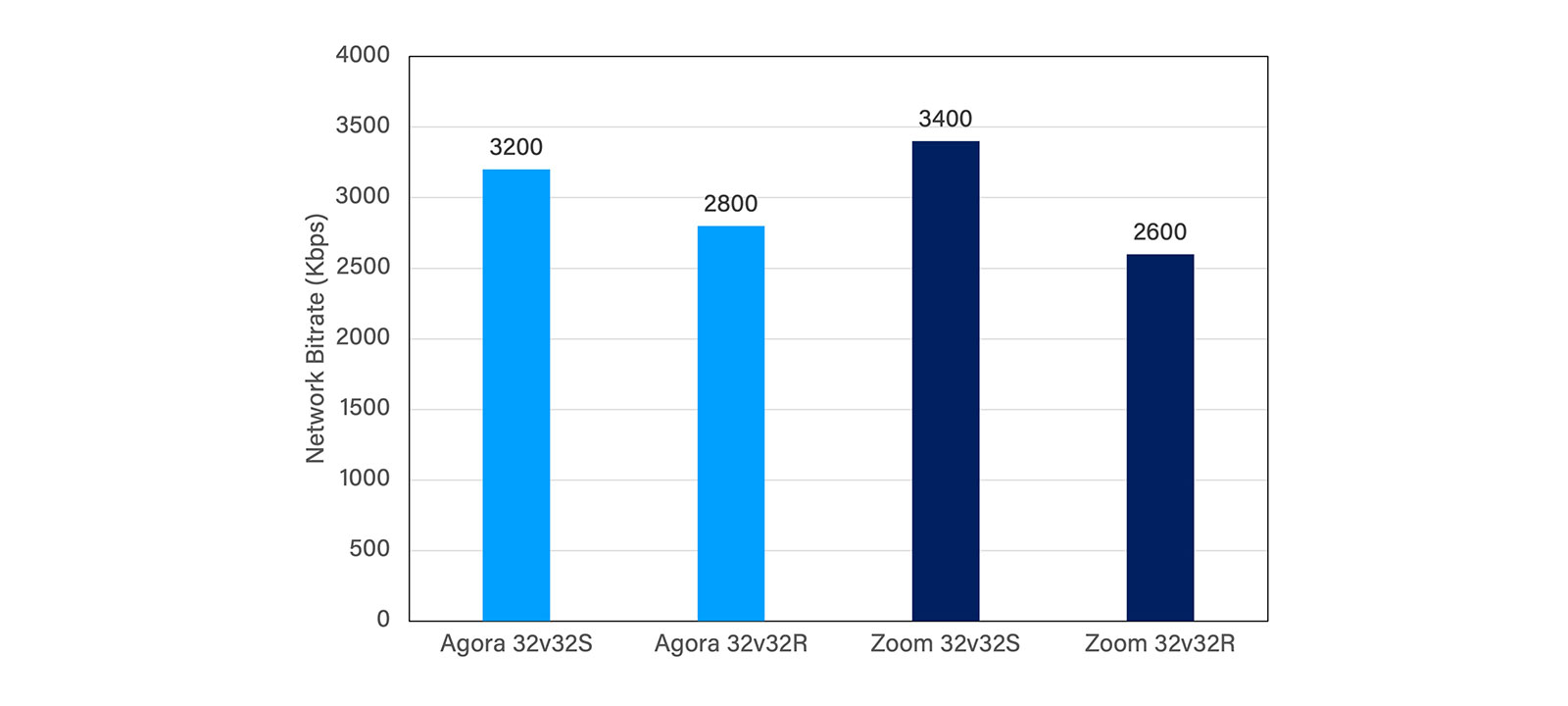
With 25% downlink packet loss, Agora and Zoom had similar sent and received bitrate performance.
CPU Utilization
During the test scenarios, we monitored the CPU utilization on the Receive Test PC (HP ProBook 630 G8 Notebook PC with an Intel Core i7-1185G7 @ 3.00 GHz processor).
For simplicity, we summarized the results for the 32-participant video scenario, which is the most resource intensive.
CPU UTILIZATION
As you can see, Agora consumed fewer CPU resources vs. Zoom in all scenarios, with an average of 1.2% utilization vs. Zoom at an average of 1.4%.
RAM Utilization
During the test scenarios, we monitored the RAM utilization on the Receive Test PC (HP ProBook 630 G8 Notebook PC with an Intel Core i7-1185G7 @ 3.00 GHz processor).
여기서 아고라는 Zoom보다 더 많은 RAM을 소비했으며, 평균 707MB 대비 Zoom은 평균 449MB였습니다. PC 사용 사례에서는 여러 응용 프로그램이 실행 중이어도 Zoom이나 Agora 모두 사용자 경험에 영향을 미치지 않을 것으로 예상됩니다. 저사양 PC는 일반적으로 8~16GB의 RAM을 기본으로 제공합니다.
결론
이 블로그에서는 8명, 16명, 32명의 참가자가 참여한 PC 환경에서 다양한 실제 네트워크 조건 하에서 Agora와 Zoom의 비디오 통화 성능을 비교했습니다.
Agora SDK는 모든 네트워크 시나리오에서 상당한 우위를 보여주었으며, 변화하는 네트워크 조건에 효율적으로 적응했습니다. 이 블로그 시리즈의 제1부에서 PC 간 1:1 통화 시나리오를 테스트한 것과 마찬가지로, Agora Video SDK는 특히 Zoom이 동결되거나 영상이 끊기는 등 더 어려운 조건에서도 더 안정적이고 효율적으로 작동했습니다. Agora는 유창하고 자연스러운 오디오와 비디오를 제공했습니다.
온라인 강의실, 가상 이벤트, 기업 협업 공간, 가상 회의 또는 메타버스에서의 활용 사례 등 어떤 환경에서도 안정성과 신뢰성은 성공과 실패를 가르는 결정적인 요소가 될 수 있습니다.
다음 내용
모든 테스트 시나리오의 요약은 이 블로그를 확인하세요:
각 테스트 사례의 상세 결과는 다른 시나리오를 다룬 블로그에서 확인하세요:
Agora의 성능을 직접 테스트해 보고 싶으신가요? 무료로 가입하세요








